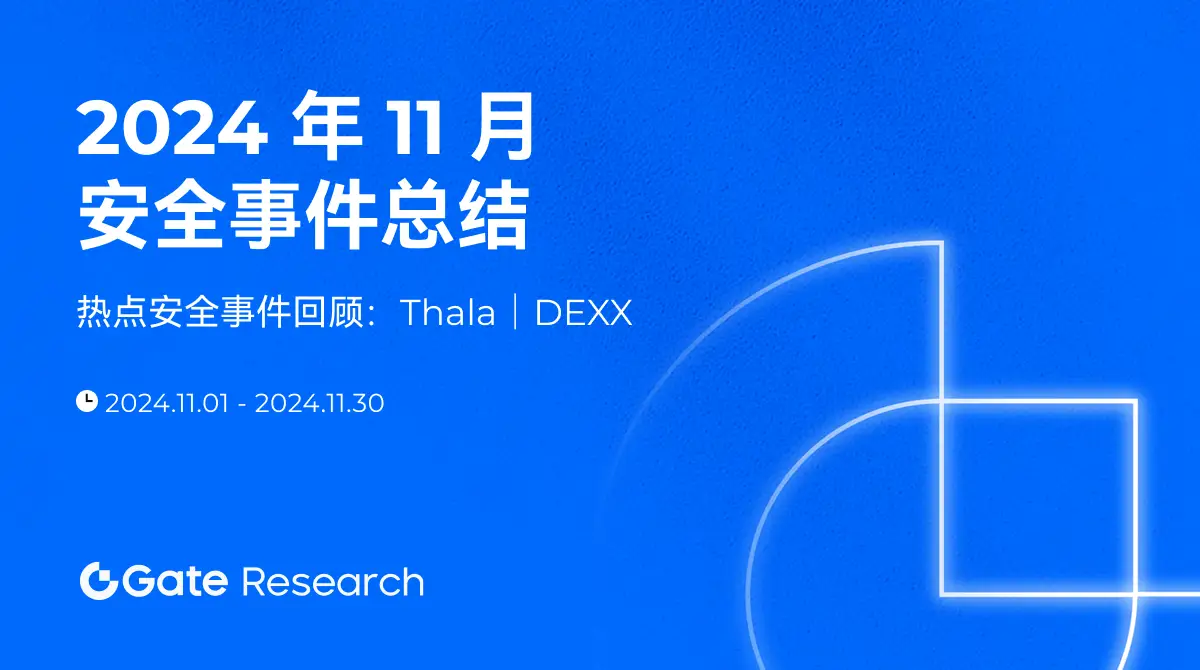深度解析稳定币的崛起与全球金融变革
稳定币支付通过区块链技术解决了传统支付方式的痛点,如即时结算、安全可靠、成本降低和全球覆盖。文中详细介绍了稳定币支付产业的格局,包括应用层、支付处理层、资产发行层和结算层,并且讨论了如何扩大稳定币的应用范围,特别是如何吸引非加密原生用户,同时分析了稳定币原生经济的潜力及其对传统金融体系的影响。稳定币有潜力重塑全球金融交易格局,但大规模采用的关键在于弥合链上生态系统与更广泛经济之间的差距。
全球金融体系正处于深刻的变革浪潮之中。传统支付网络因陈旧的基础设施、冗长的结算周期以及高昂的费用,正面临来自新兴替代方案 —— 稳定币的全方位挑战。这些数字资产正迅速革新价值跨境流动的模式、企业交易的范式以及个人获取金融服务的途径。
过去几年,稳定币持续发展,已成为全球支付的重要底层架构。大型金融科技公司、支付处理商以及主权实体,正逐步将稳定币融入面向消费者的应用程序与企业资金流。与此同时,从支付网关到出入金通道,再到可编程收益产品等一系列新兴金融工具,极大地提升了稳定币使用的便捷性。
本报告从技术与商业双重视角,深度剖析稳定币生态系统。研究塑造这一领域的关键参与者、支撑稳定币交易的核心基础设施,以及驱动其应用的动态需求。此外,还探讨稳定币如何催生新的金融应用场景,以及在广泛融入全球经济进程中所面临的挑战。
一、为何选择稳定币支付?
为探究稳定币的影响力,首先需审视传统支付解决方案。这些传统系统涵盖现金、支票、借记卡、信用卡、国际电汇(SWIFT)、自动清算所(ACH)和点对点支付等。尽管它们已融入日常生活,但许多支付通道,如 ACH、SWIFT 的基础设施自 20 世纪 70 年代便已存在。尽管当时具有开创性意义,但如今这些全球支付基础设施大多已过时,且高度碎片化。总体而言,这些支付方式受高费用、高摩擦、处理时间长、无法实现全天候结算以及后端程序复杂等问题的困扰。此外,它们还常(需付费)捆绑身份验证、借贷、合规、欺诈保护和银行集成等不必要的额外服务。
稳定币支付正有效解决这些痛点。与传统支付方式相比,利用区块链进行支付结算极大地简化了支付流程,减少了中间环节,实现了资金流的实时可视性,不仅缩短了结算时间,还降低了成本。
稳定币支付的主要优势可概括如下:
实时结算:交易近乎瞬间完成,消除了传统银行系统中的延迟。
安全可靠:区块链的不可篡改账本确保了交易的安全性与透明度,为用户提供保护。
成本降低:去除中间环节显著降低了交易费用,为用户节省开支。
全球覆盖:去中心化平台能够触及传统金融服务覆盖不足的市场(包括无银行账户人群),实现金融包容性。

二、稳定币支付行业格局
稳定币支付行业可细分为四个技术栈层次:

1. 第一层: 应用层
应用层主要由各类支付服务提供商(PSP)构成,它们将多个独立的出入金支付机构整合至统一的聚合平台。这些平台为用户提供便捷的稳定币接入方式,为在应用层开发的开发者提供工具,并为 Web3 用户提供信用卡服务。
a. 支付网关
支付网关是通过安全处理支付,促进买卖双方交易的服务。
在这一领域进行创新的知名公司包括:
Stripe:传统支付提供商,将 USDC 等稳定币整合用于全球支付。
MetaMask:本身不提供直接法定货币兑换功能,用户可通过与其第三方服务集成实现出入金操作。
Helio:45 万个活跃钱包和 6000 家商户。借助 Solana Pay 插件,数百万 Shopify 商户能用加密货币结算支付,并即时将 USDY 转换为其他稳定币,如 USDC、EURC 和 PYUSD。
Apple Pay、PayPal、Cash App、Nubank、Revolut 等 Web2 支付应用,也允许用户使用稳定币完成支付,进一步拓宽了稳定币的应用场景。
支付网关提供商的领域可明确分为两类(存在一定重迭)
1)面向开发者的支付网关;2)面向消费者的支付网关。大多数支付网关提供商往往更侧重于其中一类,进而塑造其核心产品、用户体验和目标市场。
面向开发者的支付网关旨在服务需要将稳定币基础设施嵌入其工作流程的企业、金融科技公司和企业。它们通常提供应用程序编程接口(API)、软件开发工具包(SDK)和开发者工具,以便集成到现有支付系统中,实现自动支付、稳定币钱包、虚拟账户和实时结算等功能。一些专注于提供此类开发者工具的新兴项目包括:
BVNK:提供企业级支付基础设施以便轻松集成稳定币。BVNK 提供 API 解决方案,使流程无缝衔接,拥有用于跨境商业支付的支付平台,以及允许企业持有和交易多种稳定币和法定货币的企业账户,还有为企业提供接受客户稳定币支付所需工具的商户服务。 处理超过 $100 亿美金年化交易额, 年增速 200%,估值 7.5 亿美金,客户包括非洲、拉美、东南亚等新兴地区。
Iron (in beta):提供 API 使将稳定币交易无缝集成到其现有业务中。它为企业提供全球出入金通道、稳定币支付基础设施、钱包和虚拟账户,支持定制化支付工作流程(包括定期支付、开具发票或按需支付)
Juicyway:提供一系列企业支付、薪资发放及批量支付 API,支持的货币包括尼日利亚奈拉(NGN)、加拿大元(CAD)、美元(USD)、泰达币(USDT)、美元币(USDC)。主要面对非洲市场,尚无运营数据。
面向消费者的支付网关以用户为重点,提供简单易用的界面,方便用户进行稳定币支付、汇款和金融服务。它们通常包括移动钱包、多币种支持、法定货币出入金通道和无缝跨境交易。一些专注于为用户提供这种简单支付体验的知名项目包括:
Decaf:链上银行平台,实现 184 多个国家的个人消费、汇款和稳定币交易;Decaf 在拉丁美洲与包括速汇金(MoneyGram)在内的当地通道合作,几乎实现零出金费用,有 1 万多南美用户,在 solana 开发者里评价高。
Meso:出入金解决方案,与商户直接集成,使用户和企业能够在法定货币和稳定币之间轻松转换,摩擦极小。Meso 还支持苹果支付购买 USDC,简化了消费者获取稳定币的流程。
Venmo:Venmo 的稳定币钱包功能利用了稳定币技术,但其功能集成在其现有的消费者支付应用中,使用户无需直接与区块链基础设施交互,即可轻松发送、接收和使用数字美元。
b. U 卡
加密货币卡是允许用户在传统商户处使用加密货币或稳定币消费的支付卡。这些卡通常与传统信用卡网络(如 Visa 或 Mastercard)集成,通过在销售点自动将加密货币资产转换为法定货币,实现无缝交易。
项目包括:
Reap: 亚洲发卡商,客户包括 Infini, Kast, Genosis pay, Redotpay,Ether.fi 等 40 多家企业,卖白标解决方案,主要靠交易额抽成(如 Kast 85%-Reap15%)跟香港银行合作,可覆盖美国以外大部分地区,可支持多链 deposit; 2024 年 7 月交易额达 $30M .
Raincards:美洲发卡商,支持 Avalanche, Offramp, takenos 等多家公司发卡,最大特色在于可以服务美国、拉美用户。自己发了一张 USDC 企业卡用链上资产(如 USDC)支付差旅费、办公用品和其他日常业务费用。
Fiat24: 欧洲发卡商 +web3 银行,商业模式跟以上两家类似,支持 ethsign, safepal 等企业发卡; 瑞士牌照,主要服务欧洲 + 亚洲用户,尚不支持全链交易只能 arbitrum 充值。 增长较慢总用户 2w,月收入 $100K-150K。
Kast:Solana 上增长较快的 U 卡,目前发了 1 万多张卡,5-6k 月活, 2024 年 12 月交易量 $7m, 收入 $200k。
1Money:稳定币生态系统,最近推出了支持稳定币的信用卡,并提供一个软件开发工具包,便于进行 L1 和 L2 集成,in beta 尚无数据。
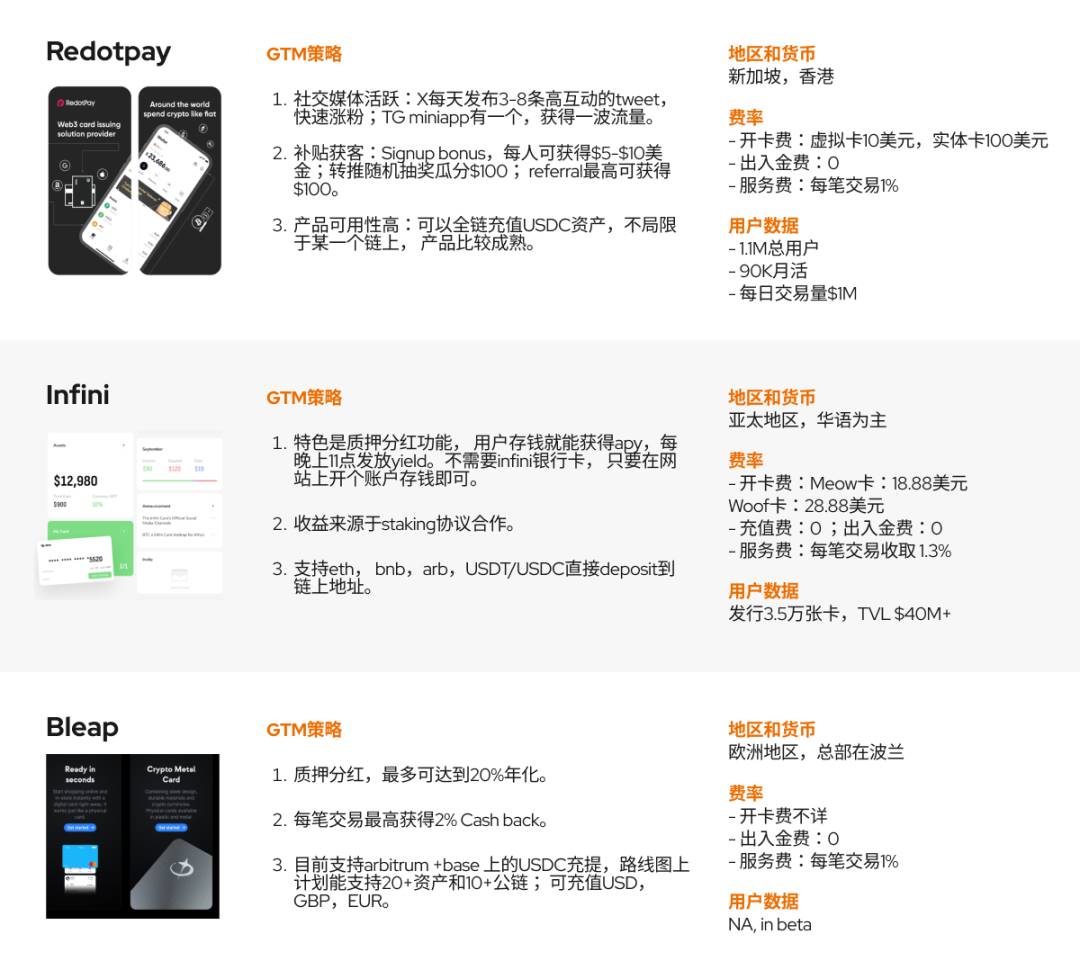
加密货币卡提供商众多,它们主要在服务地区和支持货币方面存在差异,且通常都为终端用户提供低费用服务,以提升用户使用加密货币卡的积极性。
2. 第二层:支付处理商
作为稳定币技术栈的关键层级,支付处理商是支付通道的支柱,主要涵盖两类:1. 出入金服务商 2.稳定币发行服务商。它们在支付生命周期中充当关键的中间层,将 Web3 支付与传统金融系统连接起来。
a. 出入金处理商
Moonpay:支持 80 多种加密货币,提供多种出入金方式和代币互换服务,满足用户多样化的加密货币交易需求。
Ramp Network:覆盖 150 多个国家,为 90 多种加密资产提供出入金服务。该网络处理所有的 KYC(身份验证)、AML(反洗钱)和合规要求,确保了出入金服务的合规性与安全性。
Alchemy Pay:一种混合支付网关解决方案,支持法定货币与加密资产之间的双向兑换和支付,实现了传统法定货币与加密资产支付的融合。
b. 稳定币发行 & 协调处理商
Bridge:Bridge 的核心产品包括协调 API 和发行 API,前者帮助企业集成多种稳定币支付和兑换,后者支持企业快速发行稳定币。该平台目前在美国和欧洲获得许可,并与美国国务院和财政部建立了重要合作伙伴关系,具备强大的合规运营能力和资源优势。
Brale (in beta):与 Bridge 产品类似是受监管的稳定币发行平台,提供稳定币协调和储备管理 API。在美国各州均有合规许可,合作企业都需要通过 KYB(企业身份验证),用户则需要在 Brale 设立账户进行 KYC。Brale 客户更多是链上 OG(如:Etherfuse, Penera 等)与 Bridge 比投资方背书和 BD 都略差一些。
Perena (in beta):Perena 的 Numeraire 平台通过鼓励用户在单个池中提供集中流动性,降低了小众稳定币的发行门槛。Numeraire 采用的是一种「中心枢纽 - 辐射式」模型,其中 USD 作为中心储备资产,充当稳定币发行和交换的「枢纽」。这一机制使得与不同资产或司法辖区挂钩的多种稳定币能够高效地铸造、赎回和交易,每种稳定币都作为类似的「辐条」与 USD 相连接。通过这种系统结构,Numeraire 确保了深度流动性并提升了资本效率,因为小型稳定币可通过 USD* 进行互操作,而不需要为每个交易对提供分散的流动性池。该系统最终的设计目标不仅是增强价格稳定性、减少滑点,还能实现稳定币之间的无缝转换。
3. 第三层:资产发行商
资产发行商负责创建、维护和赎回稳定币。其商业模式通常以资产负债表为核心,类似于银行运营 —— 接受客户存款,并将资金投资于美国国债等高收益资产以赚取息差。在资产发行商层面,稳定币创新可分为三个层次:静态储备支持的稳定币、生息稳定币和收益共享稳定币。
1.静态储备支持的稳定币
第一代稳定币引入了数字美元的基础模型:由传统金融机构持有的法定储备按 1:1 比例支持的中心化发行代币。这一类别中的主要参与者包括泰达币(Tether)和 Circle。
Tether 的 USDT 和 Circle 的 USDC 是使用最广泛的稳定币,均由 Tether 和 Circle 的金融账户中的美元储备按 1:1 比例支持。这些稳定币目前已与多个平台集成,并作为很大一部分加密货币交易和结算的基础货币对。值得注意的是,这些稳定币的价值获取归资产发行商本身所有。USDT 和 USDC 主要通过息差为其发行实体带来收益而不是与用户分享收益。
2.生息稳定币
稳定币的第二次演变超越了简单的法定货币支持代币,嵌入了原生收益生成功能。生息稳定币为持有者提供链上回报,通常源自短期国债收益率、去中心化金融(DeFi)借贷策略或质押奖励等机制。与被动持有储备的传统静态稳定币不同,这些资产在保持价格稳定的同时积极产生收益。
为稳定币持有者提供链上收益的知名协议包括:
Ethena($6B):稳定币协议发行 USDe- 由对冲后的以太坊(ETH)、比特币(BTC)和 Solana(SOL)抵押支持的链上合成美元。Ethena 的独特设计使 USDe 持有者能够获得源自永续期货市场资金费率的有机收益(当前年化收益率为 6.00%)通过独特的抵押和收益机制吸引用户。
Mountain($152M):当前年化收益率为 4.70% 的生息稳定币。Mountain 允许用户只需将 USDM 存入钱包,即可每日赚取利息,这对寻求被动收益而无需额外质押或参与复杂 DeFi 的用户具有吸引力,为用户提供了一种简单便捷的生息方式。
Level($25M):由流动再质押美元组成的稳定币。Level 探索了一种新的稳定币收益生成方法;它使用 lvlUSD 为多个去中心化网络提供安全保障,并收集这些网络的附加收益,然后将其传递给 lvlUSD 的持有者,创新了稳定币收益模式。
CAP Labs(Beta):建立在备受期待的 megaETH 区块链上,CAP 正在开发下一代稳定币引擎,旨在为稳定币持有者提供新的收益来源。CAP 稳定币通过利用外部收入来源(如套利、最大可提取价值(MEV)和现实世界资产(RWA)产生可扩展且适应性强的收益 —— 这些收益流传统上仅为复杂的机构参与者保留,为稳定币收益开拓了新的方向。
3.收益共享稳定币
收益共享稳定币集成了内置的货币化机制,将部分交易费用、利息收入或其他收益流直接分配给用户、发行商、终端 app 和生态系统参与者。这种模式使稳定币发行商、分销商和终端用户之间的激励保持一致,进一步将稳定币从被动支付工具转变为主动金融资产。
Paxos($72m):作为不断发展的稳定币发行商,Paxos 于 2024 年 11 月宣布推出 USDG,该稳定币受新加坡金融管理局即将出台的稳定币框架监管。Paxos 与帮助拓展网络效用的合作伙伴分享稳定币收益和储备资产产生的利息收入,包括罗宾汉(Robinhood)、安克雷奇数字(Anchorage Digital)和银河(Galaxy)等,通过合作拓展收益共享模式。
M^0($106m):M^0 团队由前 MakerDAO 和前 Circle 的资深人士组成,M^0 的愿景是充当一个简单、可信的中立结算层,使任何金融机构都能够铸造和赎回 M^0 的收益共享稳定币 「M」。M^0 协议将大部分利息收入与被称为收益者的经批准分销商分享。然而,「M」 与其他收益共享稳定币的区别之一在于,「M」 还可以用作其他稳定币(如 Noble 的 USDN)的 「原材料」
Agora($76m):与 USDG 和 「M」 类似,Agora 的 AUSD 也与集成 AUSD 的应用程序和做市商分享收益。Agora 得到了一些做市商和应用程序的战略支持包括 Wintermute、Galaxy、Consensys 和 Kraken Ventures. Agora 做 Rev-sharing 比例不是固定的,但大部分都会返给合作伙伴。
4. 第四层:结算层
稳定币技术栈的结算层是稳定币生态系统的基础,确保交易的最终性和安全性。它由实时处理和验证稳定币交易的支付通道(区块链网络)组成。如今,许多知名 L1L2 网络都充当着稳定币交易的关键结算层:
Solana:以其出色的吞吐量、快速的最终性和低费用而闻名的高性能区块链,已成为稳定币交易的关键结算层,尤其是在消费者支付和汇款方面。Solana 基金会正积极鼓励开发者在 Solana Pay 上构建,并举办 PayFi 大会 / 黑客松大力支持链下 PayFi 创新,推动稳定币在实际支付场景中的应用。
Tron:在稳定币支付领域占据重要市场份额的第一层区块链;Tron 上的 USDT 因其高效性和深度流动性,广泛用于跨境支付和点对点(P2P)交易。Tron 非常注重 B2C 交易,但目前 B2B 场景的支持不足
Codex(beta):跨境 B2B 支付的 OP L2,Codex 聚合了出入金服务提供商、做市商、交易所和稳定币发行商,为企业提供一站式稳定币金融服务。Codex 拥有强大的分销渠道,将其排序器费用的 50% 与 Circle 分享以获取其出入金的流量。
Noble:为 Cosmos 和 IBC 生态系统设计的 USDC 原生资产发行链, Cosmos 是第四大 USDC 发行链,已与 Coinbase 集成。集成 Noble 的项目可以一键将 USDC 存入 90 多个 IBC 模块化链(dYdX、Osmosis、Celestia、SEI、Injective)实现 USDC 在多链生态中的原生铸造和流通。
1Money (beta):专门为稳定币支付而构建的 L1。交易以同等优先级和固定费用平行处理,这意味着没有交易重新排序,也没有用户可以通过支付更高费用 「插队」。该网络还通过生态系统合作伙伴提供无 gas 费交易,以提升用户体验,为稳定币支付提供了公平、高效的网络环境。
三、扩大稳定币的应用:服务非加密原生用户
1. 当前瓶颈
监管不确定性:银行、企业和金融科技公司在全面采用稳定币之前,亟需监管部门提供更为明确的政策指引,以有效管控风险。
用户侧:稳定币使用场景的匮乏,制约了其在普通消费者中的普及。消费者日常使用的支付场景相对固定,而稳定币尚未能深度融入其中,许多消费者缺乏使用稳定币的实际需求与持有动机。
企业侧:企业对于稳定币支付的接受程度,极大影响着稳定币的推广进程。目前企业在接受稳定币支付时,面临着意愿与能力的双重考验。一方面,部分企业对稳定币这一新兴支付方式的认知有限,对其安全性、稳定性心存疑虑,从而导致接受意愿不高。另一方面,即便企业有接受稳定币支付的想法,在实际操作中,还可能面临技术对接、财务核算、合规监管等多方面的难题,使得其接受能力受限。
尽管诸多瓶颈,但我们认为美国监管在逐渐走向明确的过程中,必将鼓励更多传统用户和企业采用合规稳定币,虽然双方可能会面临 KYC(客户身份验证)KYB(企业身份验证)等潜在摩擦,但从长远来看市场潜力巨大。
如果将市场细分为 1. 加密原生用户 2. 非加密原生用户。访谈的所有的项目方,目标用户大都为链上市场,服务加密原生用户, 而非加密原生市场在很大程度上仍处于未开发状态。这一市场空白为创新公司提供重大机遇,使其能够在引导新用户进入加密领域方面建立先发优势。
链上方面,稳定币市场竞争已然激烈。许多参与者致力于增加用例、通过更高的收益率锁定总价值锁定(TVL),并激励用户持有稳定币。随着生态系统的发展,未来项目成功将取决于拓展现实世界的应用、促进不同稳定币之间的互操作性,以及减少企业和消费者面临的摩擦。
2. 企业侧:如何提高稳定币支付采用率?
稳定币集成到主流支付应用中:苹果支付、贝宝、Stripe 等主流支付平台已纷纷纳入稳定币交易,这一举措不仅极大地拓展了稳定币的使用场景,还能显著降低国际支付过程中的外汇费用,为企业和用户带来更为经济高效的跨境支付体验。
用收益共享稳定币(Revenue-sharing stablecoin)激励企业:收益共享稳定币将分发渠道置于优先地位,通过巧妙协调稳定币和应用之间的激励机制,构建强大的网络效应。它并非直接面向 c 端用户,而是精准瞄准金融 app 等分发渠道。Paxos 的 USDG、M0 基金会的 M 和 Agoda 的 AUSD 等 「收益共享」 稳定币便是典型代表。
企业、组织能更便捷地发行自己的稳定币:普通企业能够更为轻松地发行和管理自身的稳定币,这已成为推动企业采用稳定币的关键趋势。如 Perena Bridge, Brale 是这一领域的先行者,随着整体基础设施的持续完善,企业或国家发行专有稳定币的趋势有望进一步增强。
B2B 稳定币流动性与资金管理解决方案:助力企业妥善持有和管理稳定币资产,以满足营运资金和收益生成的需求。例如,Mountain 协议的链上收益平台,就为企业提供了专业的资金管理解决方案,有效提升企业资金运营效率。
面向开发者(企业)的支付基础设:不难发现,目前一些最为成功的平台均将自身定位为传统金融服务的加密原生版本,致力于为企业提供创新的金融解决方案。如,当前很多企业必须手动协调流动性提供商、兑换合作伙伴和本地支付渠道,使得大规模采纳稳定币效率低下,而 BVNK 通过自动化整个支付工作流程来解决这一问题,该协议还引入了一个多轨解决方案,将本地银行、加密流动性提供商和法币下链结合到一个单一的支付引擎中。BVNK 不要求企业管理多个中介,而是自动将资金通过「最快、最便宜、最可靠的通道」进行路由,实时优化每一笔交易。随着稳定币企业采纳的持续加速,像 BVNK 这样的解决方案将在使稳定币支付无摩擦、可扩展且与全球商业完全整合方面发挥关键作用。通过解决阻碍企业大规模采纳稳定币的低效问题。
专为跨境支付设计的结算网络:涵盖企业对企业跨境支付或企业对消费者零售转账等场景的专有 L1L2。其具备易于集成、全面监管的显著优势,能够有效满足企业在复杂业务场景下的支付需求。例如,Codex 作为专门为跨境交易构建的 L2,通过聚合出入金服务提供商、做市商、交易所和稳定币发行商,为企业提供一站式稳定币金融服务;Solana 全力支持 PayFi,除本身技术栈优势外,它积极向合作伙伴和当地企业推广产品,引导 Shopify、Paypal 企业及线下商户使用 Solana pay 收付款 ( 特别是在拉丁美洲、东南亚等银行服务相对薄弱地区 )。一个主要趋势是,L1L2 结算网络之间的竞争不仅仅停留在技术,未来还将涉及开发者生态、BD 商户、传统企业合作等多层面竞争。
3. 消费者侧:如何拓展非加密原生用户?
随着稳定币更易获取并融入传统金融应用,非加密原生用户将在无感知状态下开始使用它们。正如当今用户无需理解底层银行系统即可使用数字支付,稳定币将日益成为隐形基础设施,为各行业提供更快速、低成本、高效率的交易支持。
电子商务与汇款中的嵌入式稳定币支付
将稳定币应用于日常交易是推动其普及的关键动力,尤其在传统支付系统效率低下、成本高昂且依赖陈旧银行网络的电子商务和跨境汇款领域。嵌入式稳定币支付为这些场景提供了以下价值:
更快捷、低成本的支付体验: 稳定币通过消除中间环节,显著降低商户与消费者的交易费用和结算时间。当集成至主流电商平台时,其可替代信用卡网络,实现交易即时最终性并节省支付处理成本。
零工经济、跨境自由职业薪酬支付、拉美东南亚货币保值需求: 这些特定场景的需求催生了无障碍跨境支付需求。相较传统银行与汇款服务,稳定币能使零工工作者和自由职业者以更低成本实现资金秒级到账,这种优势注定使其成为全球劳动力市场的优选支付方案。
随着稳定币支付通道深度嵌入主流平台,其应用范围将突破加密货币原生用户圈层。未来,消费者将在日常金融活动中无感地使用区块链驱动的交易服务。
面向非加密用户的链上收益产品
通过数字美元获取收益是稳定币的另一核心价值主张,而这一功能在传统金融领域仍未被充分开发。尽管 DeFi 原生用户早已接触链上收益,但新兴产品正通过简化、合规的界面将这些机会带给主流消费者。
关键在于以无缝且直观的方式将传统金融用户引入链上收益领域。过去,获取 DeFi 收益需技术知识、自我托管能力及复杂协议操作经验。如今,合规平台通过抽象化技术复杂性,提供直观界面,使用户无需深究加密知识即可通过持有稳定币赚取收益。
作为这一领域的先行协议,Mountain Protocol 深刻认识到链上收益的普惠性价值。与传统稳定币仅作为交易媒介不同,Mountain 的稳定币 USDM 默认每日向持币者直接分配收益。其当前 4.70% 的年化收益率源自短期低风险美国国债,使其成为传统银行存款与 DeFi 质押机制的双重替代方案。Mountain 通过以下方式吸引非加密原生用户:
无摩擦被动收益: 用户仅需持有 USDM 即可自动累积收益,无需额外质押、参与复杂 DeFi 策略或主动管理。
合规保障: USDM 接受全面审计、全额抵押,并通过隔离的破产隔离账户结构设计,确保用户获得与链下货币市场工具同等级别的透明度和投资者保护。
链上收益风险控制: Mountain 通过将储备资产严格限定为美国国债,并同步建立以 USDC 计价的信贷额度,最大限度降低银行破产与稳定币脱钩风险,消除非加密用户对数字资产的常见顾虑。
Mountain 为非加密用户带来范式转变:对个人用户而言,USDM 提供了无需 DeFi 知识的低风险数字资产收益入口;对机构及企业资金管理部门而言,USDM 是传统银行产品的合规、稳定且生息替代品。Mountain Protocol 的长期战略包括深化 USDM 在 DeFi 与 TradFi 生态的整合、扩展多链支持,并拓展机构合作(如与贝莱德的现有合作)。这些举措将进一步简化链上收益获取路径,推动非加密用户采用稳定币。
优化 KYC 流程以实现用户无缝接入
稳定币支付要实现大规模消费级采用,KYC(了解你的客户)流程必须在合规前提下极致简化。当前阻碍非加密用户入场的关键痛点之一,是繁琐的身份验证流程。为此,领先的稳定币支付服务商正将 KYC 直接嵌入平台,实现用户流畅接入。
现代平台不再要求用户单独完成验证,而是将 KYC 整合至支付流程中。例如:
Ramp 与 MoonPay 允许用户通过借记卡购买稳定币时实时完成 KYC,减少人工审核延迟;
BVNK 为企业提供嵌入式 KYC 解决方案,在不中断支付体验的前提下快速安全完成客户认证。
跨司法辖区监管框架的碎片化仍是简化 KYC 流程的挑战。头部服务商通过模块化 KYC 框架应对区域合规差异。例如:
- Circle 的 USDC 平台采用分级验证机制,用户可通过基础 KYC 完成小额交易,并通过进阶验证解锁更高限额。
未来,通过自动化与流程优化将 KYC 转化为无感环节,将成为稳定币支付服务商打破主流用户入场壁垒、加速链上化的关键。
四、稳定币原生经济:消费者会跳过法币吗?
尽管稳定币极大地加速了全球支付进程,节省了大量时间和资金成本,但现实世界的交易目前仍依赖法定货币的出入金通道。这形成了隐喻性的 「稳定币三明治」 框架,即稳定币在交易生命周期中仅充当法定货币之间的桥梁。许多稳定币支付提供商聚焦于法定货币的互操作性,本质上使稳定币成为法定货币之间的临时转移层。然而,更具前瞻性的设想是,未来可能出现稳定币原生支付服务提供商(PSP),实现稳定币支付的原生运行。这意味着要从根本上重新构建支付体系,假设交易、结算和资金管理功能完全在链上进行。
像 Iron 这样的公司,正在这一领域积极探索创新,致力于构建一个稳定币不仅是法定货币系统之间的桥梁,更是整个链上金融生态系统基础的未来。与其他通常用稳定币复制传统金融轨道的支付解决方案不同,Iron 正着力开发以链上为优先的支付和资金管理堆栈,期望未来资金能够全程留在链上,金融市场实现真正的互操作性,在共享公共账本上实现全天候实时结算。
至于资金留在链上的未来是否可行,完全取决于消费者的选择:是将稳定币兑换为法定货币,通过传统轨道进行结算,还是将资金留在链上。有几个关键因素可能会推动这一转变:
1. 链上收益和资本效率
消费者保留资金在稳定币的一个极具说服力的理由,是能够直接在链上获取被动的、经过风险调整的收益。在稳定币原生经济中,消费者将对资金的使用拥有更强的控制权,几乎能即时获得优于传统储蓄账户的回报。但要真正实现这一目标,用户未来必须能够发现极具吸引力的收益机会,同时提供这种收益的协议必须达到几乎不存在对手方风险的成熟水平。
2. 降低对托管中介的依赖
持有稳定币使传统银行关系的必要性大大降低。如今,用户在账户托管、支付和获取金融服务等方面高度依赖银行。而稳定币实现了自我托管钱包和可编程金融,用户无需第三方中介,即可自主持有和管理资金。这在银行系统不稳定或金融服务获取受限的地区,具有尤为重要的价值。尽管自我托管模式的吸引力与日俱增,但大多数非加密原生用户要么对其缺乏了解,要么对以这种方式管理资金持谨慎态度。为进一步推动这种自我托管模式的发展,消费者可能会要求更多的监管保障和功能强大的应用。
3. 监管成熟和机构采用
随着稳定币监管的日益明确,其被接受程度不断提高,消费者对稳定币长期保值能力的信心也将不断增强。倘若大型企业、薪资发放机构和金融机构开始原生地用稳定币结算交易,用户转换回法定货币的需求将大幅减少。这就如同消费者逐渐从现金过渡到数字银行的过程,一旦新的基础设施被广泛采用,对传统系统的需求自然会下降。
值得注意的是,向稳定币原生经济的转变,最终可能会对许多现有的支付轨道造成冲击。如果消费者和企业越来越倾向于将价值存储在稳定币中,而非传统银行账户中的法定货币,这将对现有支付系统产生重大影响。信用卡网络、汇款公司和银行主要依赖交易费用和外汇价差作为收入来源,而稳定币在区块链网络上能够即时结算,成本几乎为零。若稳定币在一个国家的经济中能够像法定货币一样自由流通,这些传统支付参与者很可能会被排除在中间环节之外。
此外,稳定币原生经济还将对以法定货币为基础的银行业务模式构成挑战。在传统模式下,存款是贷款和信贷创造的基础。若资金留在链上,银行可能面临存款流失,放贷能力和从客户资金中获取收益的能力也将随之降低。这可能会加速金融系统的变革,促使去中心化和链上金融服务逐步取代银行的传统角色。
显然,只要激励措施有利于资金留在链上,理论上的稳定币原生经济就具备成为现实的可能。这种转变将是渐进的,随着链上收益机会的不断增加、银行摩擦的持续存在以及稳定币支付网络的持续成熟,消费者可能会越来越多地选择稳定币而非法定货币,导致某些传统金融轨道逐渐走向过时。
五、结论:我们如何加速稳定币采用?
支付应用层:全力简化消费者体验,构建以监管为先的稳定币解决方案,提供比 Web2 支付轨道更低的价格、更高的资产收益、更快捷方便转账体验。
支付处理商层:重点打造企业友好、开箱即用基础设施中间件。由于其业务特性,服务不同地区需要不同的牌照和合规要求,支付处理商的竞争格局仍较为分散。
资产发行商层:积极将稳定币收益传递给非加密原生公司和普通用户,以此激励用户持有稳定币而非法币。
结算网络层:L1L2 结算网络之间的竞争不仅仅只停留在技术层面,未来还将涉及开发者生态、BD 商户、传统企业合作等多层面竞争,加速稳定币支付进入现实生活。
当然,稳定币的大规模采用不仅依赖于新兴的初创公司,也离不开成熟金融巨头的协同合作。近几个月已经有四家主要的金融巨头已宣布进军稳定币领域:Robinhood 和 Revolut 正在推出稳定币,Stripe 近期收购了 Bridge 以实现更快更便宜的全球支付,Visa 尽管有自身利益考量但也在助力银行推出稳定币。
此外,我们观察到 Web3 初创公司正借助这些成熟分销渠道,通过软件开发工具包(SDK)将加密支付产品集成到现有的成熟公司中,为用户提供法定货币&加密货币支付等多元选项。这一策略有助于解决冷启动问题,一开始就与企业和用户建立信任。
稳定币有潜力重塑全球金融交易格局,但大规模采用的关键在于弥合链上生态系统与更广泛经济之间的差距。
声明:
- 本文转载自 [深潮 TechFlow],著作权归属原作者 [Alice、Max,Foresight Ventures],如对转载有异议,请联系 Gate Learn 团队,团队会根据相关流程尽速处理。
- 免责声明:本文所表达的观点和意见仅代表作者个人观点,不构成任何投资建议。
- 文章其他语言版本由 Gate Learn 团队翻译, 在未提及 Gate.com 的情况下不得复制、传播或抄袭经翻译文章。
相关文章

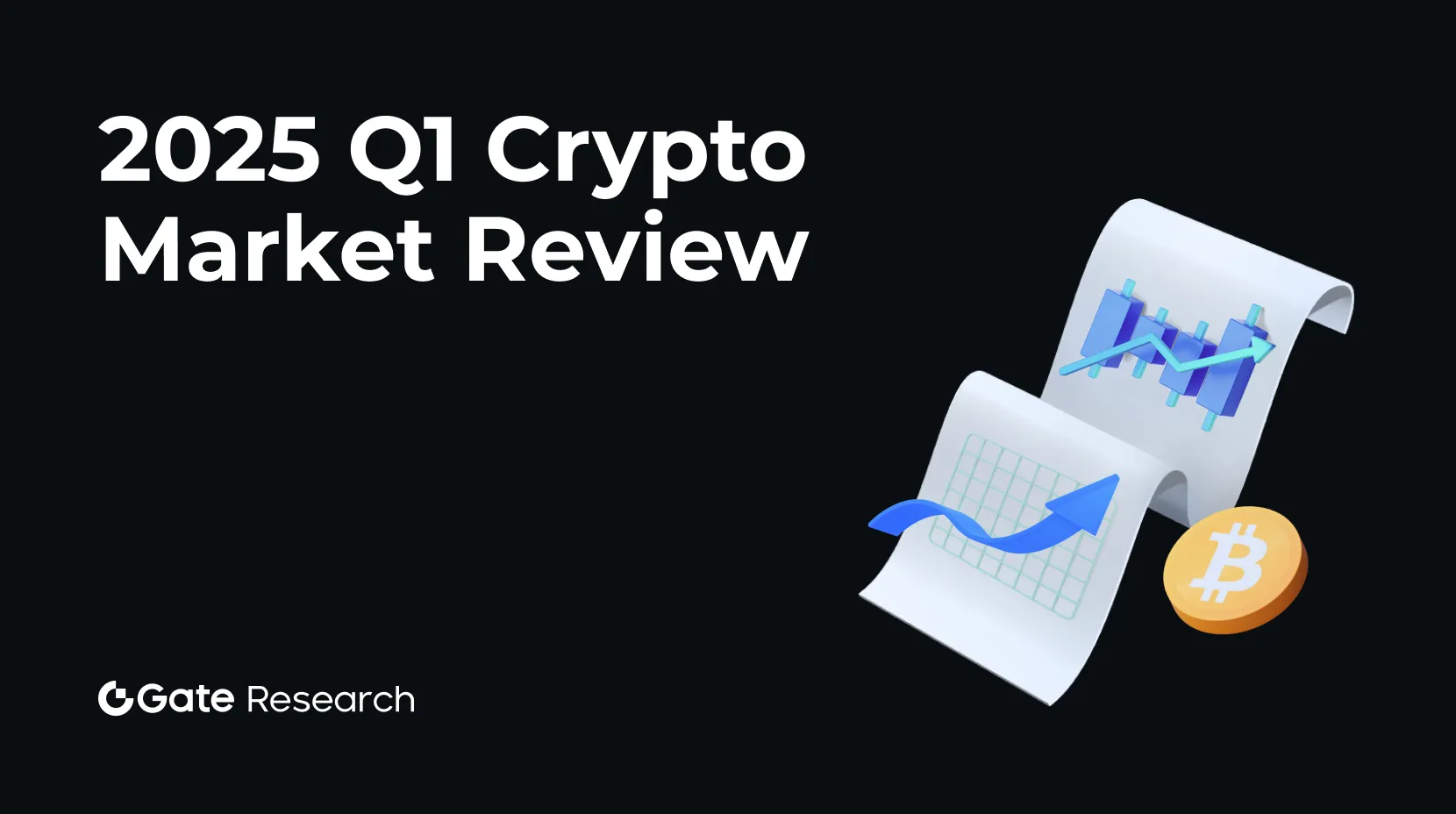
Gate 研究院:2025 年 Q1 加密货币市场回顾

Gate 研究院:加密货币市场 2024 年发展回顾与 2025 年趋势预测
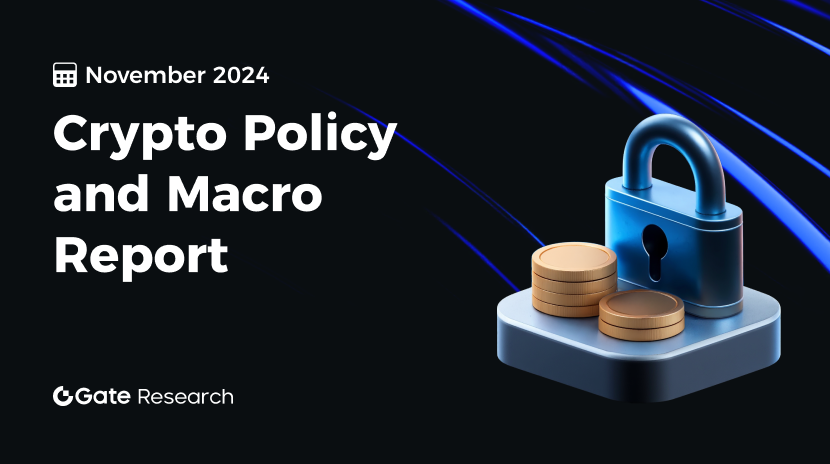
Gate 研究院:2024 年 11 月加密政策和宏观报告
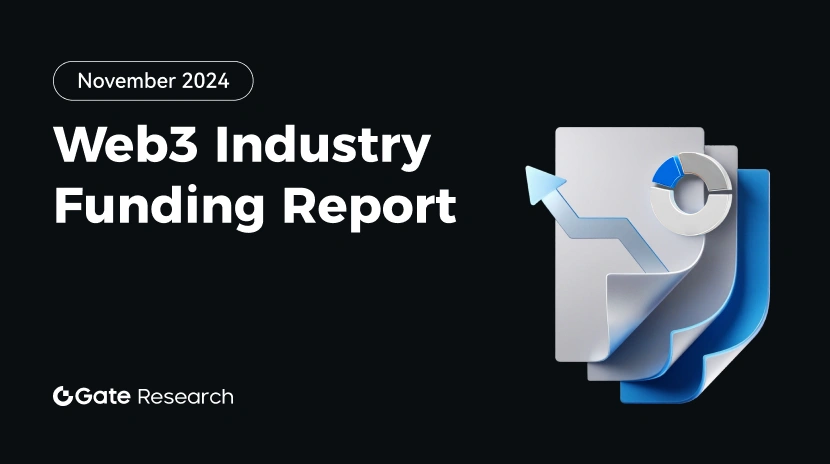
Gate 研究院:2024 年 11 月 Web3 行业融资报告
